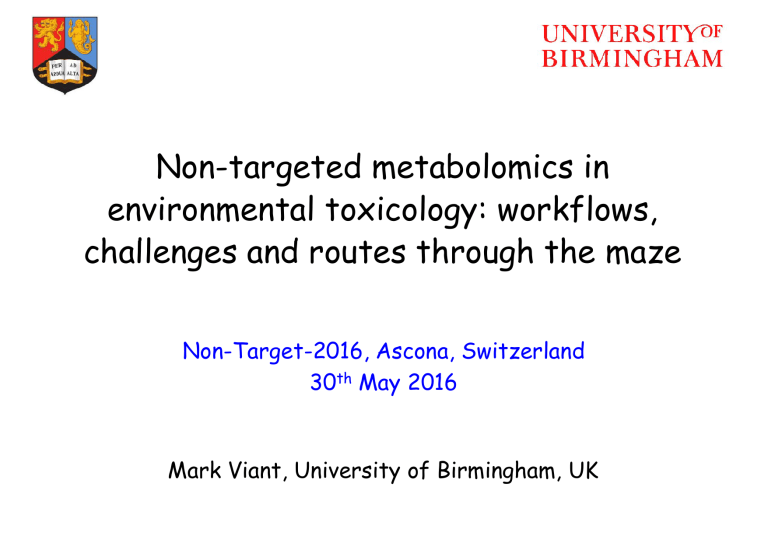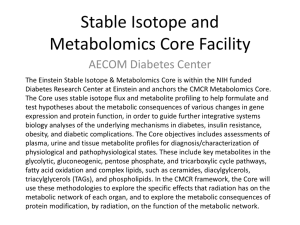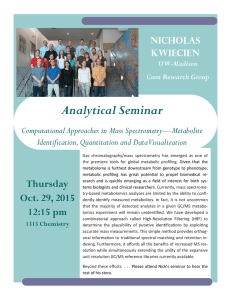Mark Viant (Uni. Birmingham, UK)
advertisement

Non-targeted g metabolomics in environmental toxicology: workflows, challenges h ll and d routes t through th h the th maze Non-Target-2016, g , Ascona,, Switzerland 30th May 2016 Mark Viant, University y of Birmingham, g UK DNA mRNA T Transcription i i Genomics Proteins T Translation l i Transcriptomics Metabolites E Enzyme activity i i Proteomics Metabolomics What makes up an organism’s metabolome? • Amino acids y • Carbohydrates • Lipids • Steroids • Secondary metabolites... metabolites • Estimated to be >10 >10,000 000 metabolites Measuring and interrogating the metabolome Mass spectrometry Computational biology NMR spectroscopy Overview 1. Introduction to environmental metabolomics 2 2. Workflows o Direct infusion mass spectrometry (standardised) o D t processing Data i (relatively ( l ti l standardised) t d di d) o Metabolite annotation and identification (not standardised) 3 3. 4. E Examples l o Endogenous metabolites o Xenobiotics within organisms Where next? Metabolomics and Environmental stress What are the effects of these stressors on living g Ocean Climate acidification organisms? change Can we develop novel information information-rich rich approaches for environmental regulation? Water pollution Air pollution Environmental monitoring • Environmental quality assessed (traditionally) by measuring pollutant levels • European Union has list of ca. 40 priority pollutants EU WFD (Water Framework Directive, 2005) - shifted h f d environmentall quality l assessments towards d integrative biological effects monitoring - currently ntl based b s d on n assessment ss ssm nt of f the th composition mp siti n & abundance of fauna and flora Need for high throughput, mechanism-based testing strategies to determine environmental health What can molecular biomarkers offer? E l i l relevance Ecological l Tissue • Lethality • Growth • Reproduction Basic scientist Molecular markers: 1 Sub-lethal effects 1. 2. Mechanistic understanding 3. Diagnostic g fingerprints g p 4. Early warning indicators Environmental regulator interested in impacts on Darwinian fitness Complexity of what we are trying to measure! Uptake, metabolism & effect of xenobiotics on organism g health Xenobiotics (>>1,000? - exposome) Chemical signalling (exometabolome) Endogenous metabolites (>10,000 forming endometabolome) • Biodiversity: 1000’s of species, p 1000’s of metabolomes • Microbiomes too! Overview 1. Introduction to environmental metabolomics 2 2. Workflows o Direct infusion mass spectrometry (standardised) o D t processing Data i (relatively ( l ti l standardised) t d di d) o Metabolite annotation and identification (not standardised) 3 3. 4. E Examples l o Endogenous metabolites o Xenobiotics within organisms Where next? Non-targeted vs. targeted metabolomic studies METABOLIC PROFILING or NON-TARGETED ANALYSIS • • • • • (Semi)-quantitative detection of a wide range of metabolites NMR or GC-MS or LC-MS Data acquisition without a priori knowledge of biologically interesting metabolites Metabolite identification requires post data acquisition Discovery/hypothesis y yp generating g g TARGETED ANALYSIS • • • • Quantification of a smaller number of ((related) l t d) metabolites t b lit f for – generally less than 20 LC-MS/MS Metabolite identity y already y known – no further metabolite identification required Hypothesis testing Generic workflow EXPERIMENTAL DESIGN BIOLOGICAL EXPERIMENT ANALYTICAL EXPERIMENT DATA INTEGRATION, ANALYSIS AND METABOLITE IDENTIFICATION BIOLOGICAL INTERPRETATION EUREKA!!!!!!! Why Direct Infusion Mass Spectrometry (DIMS)? • Non‐targeted high‐throughput screening approach • No selection bias due to LC or GC column, yet has high analytical sensitivity • P t ti ll llow(er) Potentially ( ) costt th than LC LC‐MS MS • – Higher sample throughput (few min / sample) – Potential savings on consumables Extremely high reproducibility of m/z data (ppm errors; very small compared to those of LC retention time data) • But only measures m/z (putative annotation of compounds only) • Potential for ion suppression (but much less of an issue with nano‐electrospray i i ti (nESI) ionisation ( ESI) th than with ith normall flow fl rate t ESI) Sample introduction using Triversa chip‐based nanoelectrospray l t system t • Fully automated • No sample carry-over carry over • Stable nanoelectrospray (RSDs of few %) FT‐ICR, Orbitrap and Q Exactive mass spectrometers Orbitrap spectrometer Triversa p y nanoelectrospray ion source Linear ion trap (LTQ) mass spectrometer LTQ Orbitrap O bit DIMS pipeline DIMS Experiment SIM‐Stitching Samples DI nESI high resolution MS QCs FT ICR LTQ Orbitrap FT-ICR Velos LTQ FT Ultra 2) 1) Statistics 3) Data p processingg and quality q y assessment Wide array of methods (see examples) Quality assessment Transformation Normalisation and missing values z=ln(y+√(y2+λ) 100 500 400 Ready for takeoff! 8) 7) 100 200 300 400 Variables 500 200 500 600 800 700 600 500 600 200 600 500 800 300 6) Multi‐step signal filtering 700 700 800 600 400 5) 4) SIM Stitching SIM‐Stitching 100 m/z 70 170 m/z 30 m/z 590 • Collection of multiple adjacent SIM windows that are stitched together • An optimized strategy for wide wide‐scan scan DIMS that increases dynamic range but maintains high mass accuracy (ca. 3000 m/z measurements, root mean square mass error off 0.16 ppm and d max abs b mass error off 0.29 ppm)) • Increases metabolome coverage • Now applied in other research fields, e.g. petroleomics and organic chemistry * Southam et al. Anal Chem. 79:4595‐4602 (2007 ) Weber et al. Anal Chem. 83:3737‐43 (2011 ) * Chainet et al. Anal. Chem. 2012, 84 (9):3998–4005 * Kujawinski et al. Annual Reviews of Marine Science. 2011, 3: 567‐599 O ti i d SIM Optimized SIM‐stitching tit hi parameters t Table 1. Parameters for DI SIM-stitching implemented on a LTQ FT Ultra (FT-ICR) Southam et al. Anal Chem. 79:4595‐4602 (2007 ) Weber et al. Anal Chem. 83:3737‐43 (2011 ) Southam et al. Nature Protocols (under review) Overview 1. Introduction to environmental metabolomics 2 2. Workflows o Direct infusion mass spectrometry (standardised) o D t processing Data i (relatively ( l ti l standardised) t d di d) o Metabolite annotation and identification (not standardised) 3 3. 4. E Examples l o Endogenous metabolites o Xenobiotics within organisms Where next? Data processing and quality assessment DIMS Experiment SIM‐Stitching Samples DI nESI high resolution MS QCs FT ICR LTQ Orbitrap FT-ICR Velos LTQ FT Ultra 2) 1) Statistics 3) Data p processingg and quality q y assessment Ready for takeoff! Wide array of methods (see examples) Quality assessment Transformation Normalisation and missing values z=ln(y+√(y2+λ) 100 500 400 Ready for takeoff! 8) 7) 100 200 300 400 Variables 500 200 500 600 800 700 600 500 600 200 600 500 800 300 6) Multi‐step signal filtering 700 700 800 600 400 5) 4) Multi‐step signal filtering SIM‐Stitching (1) SNR threshold (>3.5) (2) Replicate filter peaks in 2‐out‐of‐3 (3) Sample filter peaks in >=50% of biological samples Payne et al., J Am Soc Mass Spectrom. 20:1087‐95 (2009 ) Handlingg missingg values – k‐nearest neighbour g • Compared missing value imputation methods; methods we found that k‐nearest k nearest neighbour (KNN) to be superior • Uses samples with similar characteristics to impute the missing values • Intensity matrix: m/z Samples Sample 1 100 200 Sample 2 100 200 Sample 3 500 200 600 Sample 4 500 500 600 Sample 5 100 200 300 Hrydziuszko et al. Metabolomics 8:161‐174 (2012 ) 300 400 500 400 500 800 100 100 400 500 Batch ((or drift)) correction Kirwan et al. Anal Bioanal Chem 405:5147‐5157 (2013) Generalized logarithm (glog) transform 12 x 10 6 -2 PQN data with KNN MV no scaling MV, 10 -4 4 8 -5 Mean Mean Glog’ed data -3 6 -6 -7 4 -8 z=ln(y+√(y2+λ)) 2 0 100 200 300 400 Variables -9 -10 500 λ optimised using QCs 0.6 0.4 300 400 Variables 500 0.12 01 0.1 0.06 PC 2 ((24.86%) PC 2 (33.06%) 200 0.08 0.2 0 -0.2 -0.4 0.04 0.02 0 -0.02 -0.6 -0.8 100 -0.04 -0.06 -0.6 -0.4 -0.2 0 0.2 0.4 0.6 0.8 PC 1 (43.16%) -0.08 -0.08 -0.06 -0.04 -0.02 0 0.02 0.04 0.06 0.08 0.1 0.12 PC 1 (44.17%) Loadings plot dominated by very few high intensity peaks Most peaks now make some contribution to the loadings plot Glog transformation stabilises the technical variance of the peaks Quality assessment Median RSD (across 3 technical replicates) calculated for each sample for QA/QC Normalisation (PQN) Median RSD for each peak for QA/QC Missing values (KNN) Variance scaling (glog transform) Statistical analysis Parsons et al. Analyst 134:478‐485 (2009) Assess QC drift, median RSD for QA/QC, reported DIMS pipeline pp > dozen papers published 10 yrs of development Kirwan et al., Scientific Data. 1, no. 140012 (2014) Southam et al., Nature Protocols (under review) Making workflow available... Galaxy is intuitive to use and highly flexible allowing nonprogrammers to create workflows Accessibility, Standardisation & Reproducibility Davidson et al., Gigascience 5:10 (2016) Overview 1. Introduction to environmental metabolomics 2 2. Workflows o Direct infusion mass spectrometry (standardised) o D t processing Data i (relatively ( l ti l standardised) t d di d) o Metabolite annotation and identification (not standardised) 3 3. 4. E Examples l o Endogenous metabolites o Xenobiotics within organisms Where next? Metabolite identification – A BOTTLENECK B E E IN METABOLOMICS E B A For metabolomics to be successful it is essential to derive biological knowledge from analytical data ‐ a view emphasised by a Metabolomics ASMS Workshop Survey 2009 which found that the biggest bottlenecks i metabolomics in t b l i were th thought ht tto b be id identification tifi ti off metabolites t b lit (35%) and assignment of biological interest (22%) http://fiehnlab.ucdavis.edu/staff/kind/Metabolomics‐Survey‐2009 © Birmingham Metabolomics Training Centre and University of Birmingham Mass spectral data includes another level of complexity l In one sample set there were 20 different "ion types" [12C M+H]+ and 13 [ C M+H]+ NiemannPick_Posion_April11_27 #154-170 RT: 1.43-1.58 AV: 17 SB: 72 2.17-2.82 NL: 4.60E6 T: FTMS + c ESI Full ms [50.00-1300.00] 182.0806 [M-NH3]+ 34 32 30 28 Protonated and deprotonated ions [M+H]+ and [M-H]- [M-HCOOH]+ 26 Fragment g ions [M-HCOOH] + and [M-NH3] + 24 [M+Na]+ Relative Abundance 22 20 165.0549 18 16 14 12 145.0456 10 184.0652 203.0521 8 136.0754 6 187.5474 207.0112 4 132.9959 132 9959 130.0496 2 141.0772 219 0390 211.0198 219.0390 152.0435 161.0143 0 125 130 135 140 145 223.0621 226.0456 148.0954 150 155 160 165 FT Artefact peaks 170 191.0203 195.0967 179.0367 166.9478 175 180 m/z 185 190 195 200 229.1487 231.8173 214.2057 205 210 215 220 225 230 Adduct ions [M+HCOOK] +, [M+HCOONa] + [M+3HCOONa] + [M+NaCl+HCOONa] + [M+3NaCl] l+ [M+Fe]2+ [M+Cu]2+ There is structure to the data - Apply pp y RT, response p correlation, m/z difference to group metabolite features of same metabolite Typical workflows for metabolite annotation & identification (DIMS (DIMS, LC LC-MS…) MS ) Accurate A t m/z / measurement and ion type characterisation De novo structural characterisation Convert m/z to molecular formula(s) – apply 7 golden rules, isotopic information f Match MSn data to mass spectral database Match molecular formula to metabolite(s) in chemical or metabolite database MS/MS or MSn data acquisition (on-line ) Retention time prediction? MI-Pack – Metabolite Identification Package Additionally can use knowledge of metabolic pathways PutMetID - Conversion to molecular formula and then metabolite Apply pp y RT, response p correlation, m/z difference to group features of same metabolite ANNOTATION OF ALL FEATURES BASED ON ACCURATE MASS DIFFERENCES, RETENTION TIME AND CORRELATION ANALYSIS MATCHING OF ACCURATE MASS TO MOLECULAR FORMULA(E) IN REFERENCE FILE MATCHING OF MOLECULAR FORMULA(E) TO METABOLITE(S) IN A REFERENCE FILE (E.G. MMD) Annotation vs vs. Identification • Identification = two orthogonal properties (RT, MS/MS) compares to authentic chemical standard under identical analytical y conditions • Annotation = one (or more) orthogonal property match to databases (not necessarily acquired under identical analytical conditions) Salek et al., Gigascience 2:13 (2013) Four levels of confidence • • • Sumner et al. Proposed minimum reporting standards for chemical analysis Metabolomics, analysis, Metabolomics 2007, 2007 3:211-221 3:211 221 Currently, four levels of metabolite identifications can be reported Not defining how to perform metabolite identification but defining how to report it Overview 1. Introduction to environmental metabolomics 2 2. Workflows o Direct infusion mass spectrometry (standardised) o D t processing Data i (relatively ( l ti l standardised) t d di d) o Metabolite annotation and identification (not standardised) 3 3. 4. E Examples l o Endogenous metabolites o Xenobiotics within organisms Where next? Experimental design Individual Daphnia Chemical exposures Measure Measure reproductive metabolism fit ss fitness Cadmium Propranolol Dinitrophenol (DNP) of individual Daphnia Multivariate PLS regression to d t min determine whether metabolites can predict reproductive fit ss fitness Pre edicted reproductive o output ussing metabolic biomarkers Metabolic biomarkers can also predict reproductive fitness in response to all 3 toxicants r2 (CV) = 0.91 Measured reproductive output Optimal PLS regression model: 49 peaks derived using forward selection Which metabolites predict reproductive fitness? Putative annotation of 49-biomarker signature using MI-Pack Metabolite identification confirmed by MS/MS of metabolite sample compared to pure standard Measured m/z 175.02480 Empirical formula(e) C6H8O6 [M‐H]‐ Mass error (ppm) ‐0.08 Ascorbic acid (confirmed by MS/MS) 243.00911 C7H10O7 [M+37Cl]‐ 0.01 Methylcitrate or homocitrate 258.05642 C8H15NO6 [M+37Cl]‐ 0.11 N‐Acetyl‐D‐hexosamine Ion form Putative metabolite name(s) etc… “Ascorbic acid has long been associated with fertility” Luck et al al., Biol Biol. Reprod Reprod. 52 52, 262-266 262 266 (1995) “We conclude that ascorbic acid is a leading nutrient in reproductive tissue functions [[in n tteleost ost f fish]” sh] Da Dabrowski rows & Ciereszko, r sz o, Aquacult. quacu t. Res. s. 32,, 623-638 6 6 8 ((2001)) Overview 1. Introduction to environmental metabolomics 2 2. Workflows o Direct infusion mass spectrometry (standardised) o D t processing Data i (relatively ( l ti l standardised) t d di d) o Metabolite annotation and identification (not standardised) 3 3. 4. E Examples l o Endogenous metabolites o Xenobiotics within organisms Where next? Complexity of one exogenous (xenobiotic) compound Non‐targeted Non targeted metabolomics Liver & testes NMR testes FT-ICR MS testes NMR liver FT-ICR MS liver Fenitrothion Metabolism (1) Observed m/z Tissue p‐value 261.99450 Liver Fold change HD/SC / HD/LD / 1.10×10‐15 ∞ 24.83 261 99444 261.99444 12 T Testes 2.61×10 2 61 10‐12 ∞ 33 82 33.82 320.09224 Liver 73.44 15.32 320 09240 320.09240 T t Testes 3.14×10 3 14 10‐99 9 82 9.82 9 41 9.41 2.09×10‐14 Empirical formulae Metabolite identification C8H10NO5PS [M‐H] [M H]‐ Desmethyl‐ fenitrothion C11H19N3O6S [M‐H] [M H]‐ S‐methyl‐ glutathione S‐meethyl‐glu utathione [M‐H]]‐ S‐meethyl‐glu utathione [M‐H]]‐ Fenitrothion Metabolism (2) Liver r = 0.893 p = 1.7x10‐10 Desmethylfenitrothion [M‐H]‐ Testes r = 0.936 p = 2.9x10‐14 Desmethylfenitrothion [M‐H]‐ Fenitrothion de‐methylation: + GSH + Findings from fenitrothion study 1) Endogenous metabolism: fenitrothion significantly disrupts acetylcholine disrupts key steroids acetylcholine, steroids, affects energy metabolism and disrupts phenylalanine metabolism 2) Xenobiotic metabolism: O‐demethylation observed as the major route of fenitrothion detoxification in roach. Southam et al., Environ Sci Technol 45:3759‐3767 (2011) Complexity of complex, uncharacterised mixture of exogenous (xenobiotic) compounds Testes Non‐targeted metabolomics Xenobiotics and metabolised xenobiotics discovered in fish testes Southam et al., Metabolomics 10:1050‐1058 (2014) Overview 1. Introduction to environmental metabolomics 2 2. Workflows o Direct infusion mass spectrometry (standardised) o D t processing Data i (relatively ( l ti l standardised) t d di d) o Metabolite annotation and identification (not standardised) 3 3. 4. E Examples l o Endogenous metabolites o Xenobiotics within organisms Where next? Reflect on current status… status 1. Metabolomics workflows, both analytical and computational are improving and there is increasing computational, trend towards harmonisation 2 2. Metabolomics community is generally in favour of open access / data sharing etc. 3 3. Yett metabolite Y t b lit identification id tifi ti remains i ah huge challenge 4 4. How d H do we accelerate l research h into metabolite b l identification? Focus on Model Organism Metabolomes Existing expt’al observations from literature (text mining) Comprehensive p database of 1000’s of identified metabolites for each Model Organism Metabolome (open access) Predicted metabolism: genome wide metabolic reconstruction New expt’al data: more exhaustive analytical methods ((Martin Jones talk)) International coordination: new Metabolomics Society Task k Group G Daphnia Deep Metabolome Annotation Project (M ti J (Martin Jones’’ ttalk lk thi this Th Thursday) d ) • Multi-platform characterisation: extensive extraction & fractionation chemistries chemistries, chromatography (LC (LC, GC GC,...), ) detectors (mass spectrometry, NMR spectroscopy...) • Databases: new local database, mzCloud, and MetaboLights • Part of University of Birmingham’s Technology Alliance Partnership with Thermo Fisher Scientific Environmental Metabolomics @ University of Birmingham Martin Jones Dr Ulf Sommer Dr Jaspreet Sihra Dr Adam Hines Dr Andrew Southam Dr Nadine Taylor Dr Ralf Weber T Tom Lawson L Dr Cate Winder Dr Warwick Dunn Prof Charles Tyler (Exeter) Prof Elizabeth Hill (Sussex) Prof Kevin Chipman p Dr Michael Cunliffe (Plymouth) http://www.birmingham.ac.uk/research/activity/metabolomics







